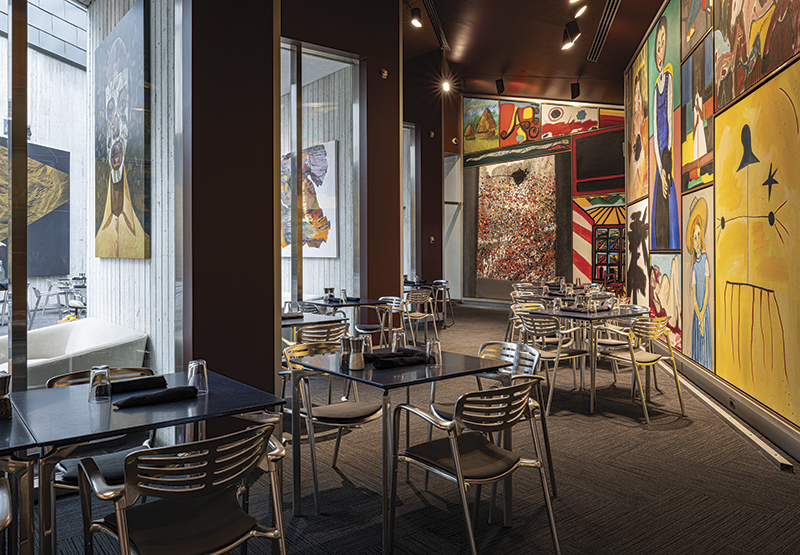
When the Kemper Museum of Contemporary Art opened in 1994, nestled between the Country Club Plaza to the west and the Nelson Atkins Museum of Art to the east, it not only highlighted the importance of contemporary art, but it also added a new restaurant to Kansas City’s culinary art scene with Café Sebastienne.
The full-service restaurant, located in the heart of the museum, has an indoor courtyard connected to a smaller restaurant space that features 110 paintings collectively known as The History of Art by renowned artist Frederick J. Brown. As a nod of appreciation to the artist, the restaurant was named after Brown’s daughter, Sebastienne, and his work is still on display in the restaurant today.
A year after the museum opened, the chef Jennifer Maloney was hired to run Café Sebastienne and for 22 years, she and her sous chef, Janet Ross, cooked deliciously simple, seasonal dishes using local produce and meats. When Maloney died in 2016, the city not only lost a great chef, but an amazing human being with a big heart.
Today there’s a new chef/partner running the restaurant inside the Kemper, one who knew Maloney personally, and who is excited to add to the culinary legacy that she and every chef who came after her have continued to expand upon during their time in this kitchen.
Ted Habiger, a three-time James Beard Foundation Award-nominated chef and entrepreneur, is known for his strong commitment to local farmers. It was announced last year that he and his partner, Tiffany Thompson, along with the seasoned restaurant team from his restaurant, Room 39, would be opening Oil on Linen, a new restaurant concept inside the museum.
Keeping the original artwork in the dining room, Habiger and Thompson turned their focus to what has been named the Chef Jennifer Maloney courtyard, working together to develop a new look and feel for the large public space. They chose moody shades of silvery gray, charcoal, and slate to dress the courtyard, which now has a cool, modern, even edgy, feel at night. With a soft gray carpet covering most of the floor in the newly appointed courtyard, the noise from the original Jorge Pensi-designed Toledo metal chairs is now buffered. A handsome piece of custom-made furniture by Kansas City-based designer Matt Castilleja provides a natural division of the room, making it more intimate. Tucked into the corners are soft couches and modern chairs to encourage people to land with their laptops to work or as a place to meet a friend for a quick drink and a bite on a Thursday night.

Thompson, as the founding member of Petrichor Projects, curated the artwork for the courtyard from the Kansas City-based, internationally acclaimed collection of Bill and Christy Gautreaux, which features pieces from artists Sanford Biggers, Ronald Jackson, Annie Lapin, and Joiri Minaya. But the centerpiece of the room is a durational drawing titled set in place (mis en place) executed by Kansas City-based artist Kevin Townsend. He began drawing the piece in September 2024 and over the course of 200 hours, evolved his dot-based drawing in full view of diners.
Oil on Linen is open for coffee, brunch, or lunch Wednesday through Sunday from 10 a.m. until 3 p.m. On Thursdays, Oil on Linen stays open for small bites and cocktails from 3:00 until 4:30 p.m. Thursday dinner service begins at 4:30 p.m. with a last seating at 7:45 p.m. Dinners have three four-course prix fixe menus, one for omnivores, one for pescatarians, and another for vegetarians. They cost between $55 to $65, depending on the menu you choose, with the option to order a la carte if you want to mix things up a bit. To experience the variety of the menu, I ordered a la carte.
Just as the museum’s exhibition calendar frequently changes to feature new and exciting artists, Habiger is changing the menu to honor each of the new exhibits coming into the museum. In November, Mexican artist Lucía Vidales was the featured atrium artist on display, and so for his first menu Habiger and his culinary team drew on foods and flavors from Mexico.
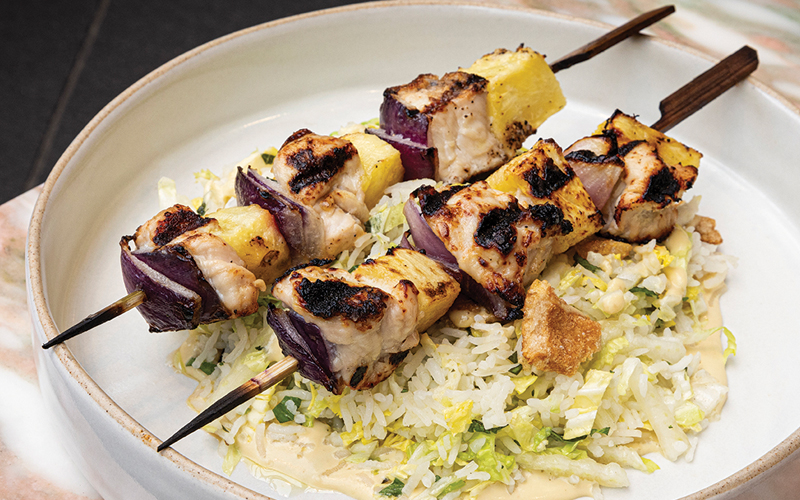
Although it has a nice bottle list, I opted for a glass of wine. All three of the amuse courses were ordered for the table. Three small, round dishes were delivered simultaneously: One with three perfectly cylindrical towers of alternating stacked slices of jicama, radish, and cucumber dusted with Tajin; next, a slice of cucumber with a mayonnaise marinated and grilled shrimp strewn with a smattering of diced fresh mango; lastly, a crispy plantain chip topped with a luscious guacamole and chapulines, or crickets, a Mexican delicacy. Each was cool and refreshing, with clean, crisp flavors preparing my palate for what was to follow.
From there, I skipped around the menu, ordering two “primero” courses, one from the omnivore menu and the other from the pescatarian menu. The first was a crunchy salad of shaved Brussels sprouts, chicharrón serving as flavorful croutons, thick-cut bacon lardons, smoked Fresno peppers, fresh mint, and pickled shallots, all bathed in a light and flavorful dressing. The bacon and chicharrónes added a satisfying meatiness to the salad, accompanied by the crunch of the Brussels sprouts and the puckering vinegar of the pickled shallots, all accented with pops of fresh mint. It was hugely satisfying.
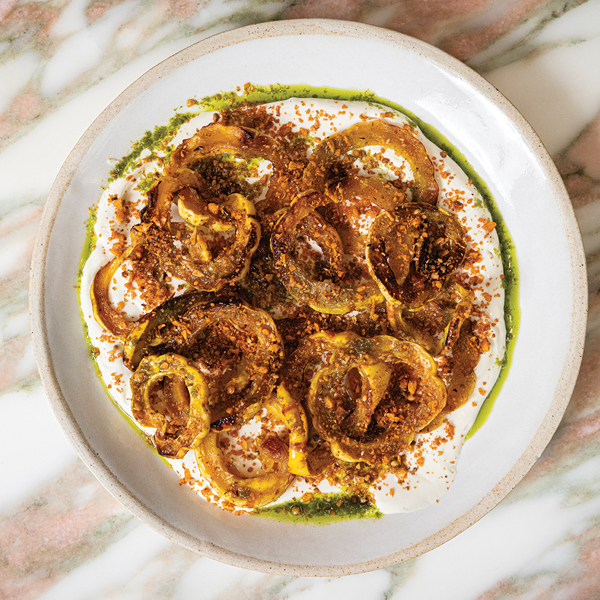
The other primero dish was a refreshing crudo of five slices of raw kanpachi, or yellowtail, fanned out on the plate nestled in fresh orange-hued agua chile speckled with neon green dots of floating herb oil, adding a bright green, grassy punch to the plate. The slices of fish were decorated with a few radish slices, bright orange trout roe, and tiny pieces of sweet and salty seeded brittle that made this dish the success that it was.
The main courses, or plato principals, I ordered were the squash entrée from the vegetarian menu and the strip steak from the omnivore menu. Opposite ends of the spectrum, but each well executed and delicious.
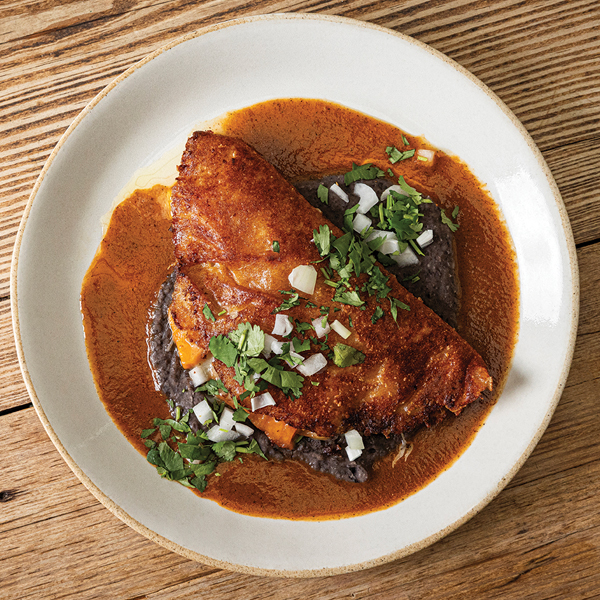
The mole blanco that the tender slices of roasted delicata squash were bathed in piqued my interest, as mole blanco is one of Oaxaca’s rarest mole recipes—mostly made at home during the holidays. The creamy white mole was punctuated with a variety of nuts blended with garlic, onion, chicken broth, and chiles for heat. The sweet, tender rings of squash nestled into the garlicky mole were topped with charred baby turnips and a healthy sprinkle of cured egg yolk, adding a bit of richness, along with a handful of chopped macadamia nuts for texture. It was deceivingly simple to look at but truly complex in flavor.
The strip steak was a bit beefier, cooked to a perfect medium, then sliced into large chunks swimming in a pool of creamy yogurt. Red and yellow charred beets and a circle of charred green onion were seasoned with a hit of heat from salsa macha, a Latin cousin to the Asian chili oil that’s everywhere right now. The quality of the meat really shone through in the rich and buttery flavor of this dish. The heat of the salsa macha was quickly cooled by the creamy yogurt and the earthy sweetness of the beets.
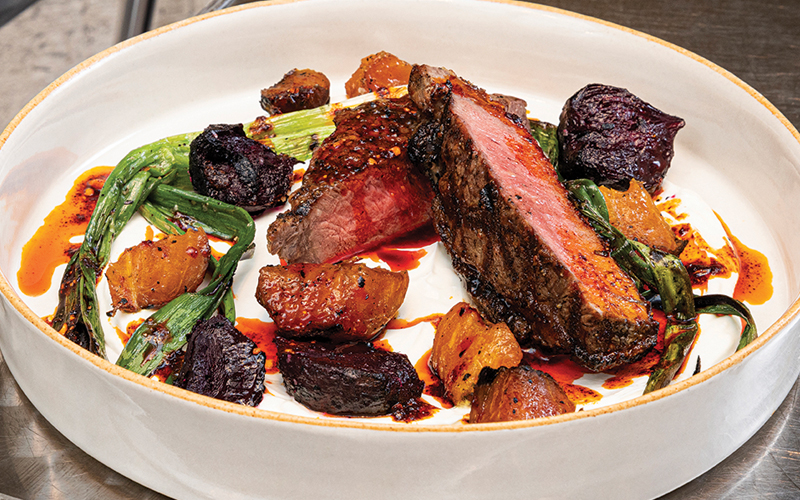
For dessert, a scoop of goat-cheese ice cream topped with grilled and diced pineapple, pine nuts, and honey was tasty, but played second fiddle to the star of the show—the caramelized bruléed banana resting atop horchata rice pudding accompanied by a little cajeta and a crispy chocolate tuille. The warming spices added a deep, rich flavor to the creamy rice pudding swirled with the caramelized banana. In four bites the dessert was gone.
It’s thrilling to see someone with the talent and experience of Ted Habiger at the helm of something as important as the restaurant of an art museum that sees more than 100,000 visitors annually.
He has perfected his art; it just happens to rest on the plate instead of the canvas.


